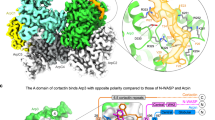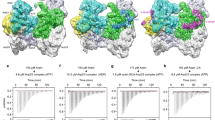Abstract
Formins are involved in a variety of cellular processes that require the remodelling of the cytoskeleton. They contain formin homology domains FH1 and FH2, which initiate actin assembly1,2. The Diaphanous-related formins form a subgroup that is characterized by an amino-terminal Rho GTPase-binding domain (GBD) and an FH3 domain, which bind somehow to the carboxy-terminal Diaphanous autoregulatory domain (DAD) to keep the protein in an inactive conformation3,4. Upon binding of activated Rho proteins, the DAD is released and the ability of the formin to nucleate and elongate unbranched actin filaments is induced. Here we present the crystal structure of RhoC in complex with the regulatory N terminus of mammalian Diaphanous 1 (mDia1) containing the GBD/FH3 region, an all-helical structure with armadillo repeats. Rho uses its ‘switch’ regions for interacting with two subdomains of GBD/FH3. We show that the FH3 domain of mDia1 forms a stable dimer and we also identify the DAD-binding site. Although binding of Rho and DAD on the N-terminal fragment of mDia1 are mutually exclusive, their binding sites are only partially overlapping. On the basis of our results, we propose a structural model for the regulation of mDia1 by Rho and DAD.
This is a preview of subscription content, access via your institution
Access options
Subscribe to this journal
Receive 51 print issues and online access
$199.00 per year
only $3.90 per issue
Buy this article
- Purchase on Springer Link
- Instant access to full article PDF
Prices may be subject to local taxes which are calculated during checkout




Similar content being viewed by others
References
Wallar, B. J. & Alberts, A. S. The formins: active scaffolds that remodel the cytoskeleton. Trends Cell Biol. 13, 435–446 (2003)
Zigmond, S. H. Formin-induced nucleation of actin filaments. Curr. Opin. Cell Biol. 16, 99–105 (2004)
Alberts, A. S. Identification of a carboxyl-terminal diaphanous-related formin homology protein autoregulatory domain. J. Biol. Chem. 276, 2824–2830 (2001)
Watanabe, N., Kato, T., Fujita, A., Ishizaki, T. & Narumiya, S. Cooperation between mDia1 and ROCK in Rho-induced actin reorganization. Nature Cell Biol. 1, 136–143 (1999)
Pruyne, D. et al. Role of formins in actin assembly: nucleation and barbed-end association. Science 297, 531–532 (2002)
Sagot, I., Rodal, A. A., Moseley, J., Goode, B. L. & Pellmann, D. An actin nucleation mechanism mediated by Bni1 and profilin. Nature Cell Biol. 4, 626–631 (2002)
Kovar, D. R., Kuhn, J. R., Tichy, A. L. & Pollard, T. D. The fission yeast cytokinesis formin Cdc12p is a barbed end actin filament capping protein gated by profilin. J. Cell Biol. 161, 875–887 (2003)
Li, F. & Higgs, H. N. The mouse Formin mDia1 is a potent actin nucleation factor regulated by autoinhibition. Curr. Biol. 13, 1335–1340 (2003)
Shimada, A. et al. The core FH2 domain of diaphanous-related formins is an elongated actin binding protein that inhibits polymerization. Mol. Cell 13, 511–522 (2004)
Xu, Y. et al. Crystal structures of a Formin Homology-2 domain reveal a tethered dimer architecture. Cell 116, 711–723 (2004)
Zigmond, S. H. et al. Formin leaky cap allows elongation in the presence of tight capping proteins. Curr. Biol. 13, 1820–1823 (2003)
Kato, T. et al. Localization of a mammalian homolog of diaphanous, mDia1, to the mitotic spindle in HeLa cells. J. Cell Sci. 114, 775–784 (2001)
Etienne-Manneville, S. & Hall, A. Rho GTPases in cell biology. Nature 420, 629–635 (2002)
Nakano, K. et al. Distinct actions and cooperative roles of ROCK and mDia in Rho small G protein-induced reorganization of the actin cytoskeleton in Madin-Darby canine kidney cells. Mol. Biol. Cell 10, 2481–2491 (1999)
Watanabe, N. et al. p140mDia, a mammalian homolog of Drosophila diaphanous, is a target protein for Rho small GTPase and is a ligand for profilin. EMBO J. 16, 3044–3056 (1997)
Gasman, S., Kalaidzidis, Y. & Zerial, M. RhoD regulates endosome dynamics through Diaphanous-related Formin and Src tyrosine kinase. Nature Cell Biol. 5, 195–204 (2003)
Peng, J., Wallar, B. J., Flanders, A., Swiatek, P. J. & Alberts, A. S. Disruption of the Diaphanous-related formin Drf1 gene encoding mDia1 reveals a role for Drf3 as an effector for Cdc42. Curr. Biol. 13, 534–545 (2003)
Blumenstein, L. & Ahmadian, M. R. Models of the cooperative mechanism for Rho-effector recognition: Implications for RhoA-mediated effector activation. J. Biol. Chem. 279, 53419–53426 (2004)
Herrmann, C., Horn, G., Spaargaren, M. & Wittinghofer, A. Differential interaction of the ras family GTP-binding proteins H-Ras, Rap1A, and R-Ras with the putative effector molecules Raf kinase and Ral-guanine nucleotide exchange factor. J. Biol. Chem. 271, 6794–6800 (1996)
Krebs, A., Rothkegel, M., Klar, M. & Jockusch, B. M. Characterization of functional domains of mDia1, a link between the small GTPase Rho and the actin cytoskeleton. J. Cell Sci. 114, 3663–3672 (2001)
Li, F. & Higgs, H. N. Dissecting requirements for auto-inhibition of actin nucleation by the formin, mDia1. J. Biol. Chem. 280, 6986–6992 (2005)
Rose, R., Wittinghofer, A. & Weyand, M. The purification and crystallization of mDia1 in complex with RhoC. Acta Crystallogr. F 61, 225–227 (2005)
Huber, A. H., Nelson, W. J. & Weis, W. I. Three-dimensional structure of the armadillo repeat region of β-catenin. Cell 90, 871–882 (1997)
Dvorsky, R., Blumenstein, L., Vetter, I. R. & Ahmadian, M. R. Structural insights into the interaction of ROCKI with the switch regions of RhoA. J. Biol. Chem. 279, 7098–7104 (2004)
Maesaki, R. et al. The structural basis of Rho effector recognition revealed by the crystal structure of human RhoA complexed with the effector domain of PKN/PRK1. Mol. Cell 4, 793–803 (1999)
Vetter, I. R. & Wittinghofer, A. The guanine nucleotide-binding switch in three dimensions. Science 294, 1299–1304 (2001)
Shimizu, T. et al. An open conformation of switch I revealed by the crystal structure of a Mg2+-free form of RhoA complexed with GDP. Implications for the GDP/GTP exchange mechanism. J. Biol. Chem. 275, 18311–18317 (2000)
Sahai, E., Alberts, A. S. & Treisman, R. RhoA effector mutants reveal distinct effector pathways for cytoskeletal reorganization, SRF activation and transformation. EMBO J. 17, 1350–1361 (1998)
Ehresmann, B., Imbault, P. & Weil, J. H. Spectrophotometric determination of protein concentration in cell extracts containing tRNA's and rRNA's. Anal. Biochem. 54, 454–463 (1973)
Rittinger, K. et al. Crystal structure of a small G protein in complex with the GTPase-activating protein rhoGAP. Nature 388, 693–697 (1997)
Acknowledgements
We thank P. Stege and D. Kuehlmann for expert technical assistance, T. Lorenz for the cloning of RhoC, I. Schlichting and W. Blankenfeldt for X-ray data collection, and the ESRF and DESY staff for support. A.W. thanks the Deutsche Forschungsgemeinschaft for financial support.
Author information
Authors and Affiliations
Corresponding author
Ethics declarations
Competing interests
The authors declare that they have no competing financial interests.
Supplementary information
Supplementary Figure S1
Sequence alignment of Diaphanous-related formins. (PDF 12 kb)
Supplementary Figure S1 Legend
Legend for Supplementary Figure S1 (PDF 12 kb)
Supplementary Figure S2
Induction of stress-fibre formation in HeLa cells by RhoA mutants. (PDF 125 kb)
Supplementary Table S1
Binding constants for the tested combinations of mDiaN and Rho/DAD constructs as determined by stopped flow and ITC measurements. (PDF 26 kb)
Supplementary Table S2
Phasing Statistics. (PDF 24 kb)
Supplementary Table S3
Refinement Statistics. (PDF 45 kb)
Rights and permissions
About this article
Cite this article
Rose, R., Weyand, M., Lammers, M. et al. Structural and mechanistic insights into the interaction between Rho and mammalian Dia. Nature 435, 513–518 (2005). https://doi.org/10.1038/nature03604
Received:
Accepted:
Published:
Issue Date:
DOI: https://doi.org/10.1038/nature03604
This article is cited by
-
Fine-tuning cell organelle dynamics during mitosis by small GTPases
Frontiers of Medicine (2022)
-
Structure and function of the N-terminal extension of the formin INF2
Cellular and Molecular Life Sciences (2022)
-
Mapping the proximity interaction network of the Rho-family GTPases reveals signalling pathways and regulatory mechanisms
Nature Cell Biology (2020)
-
The formin INF2 in disease: progress from 10 years of research
Cellular and Molecular Life Sciences (2020)
-
Cytoplasmic sequestration of the RhoA effector mDiaphanous1 by Prohibitin2 promotes muscle differentiation
Scientific Reports (2019)
Comments
By submitting a comment you agree to abide by our Terms and Community Guidelines. If you find something abusive or that does not comply with our terms or guidelines please flag it as inappropriate.



